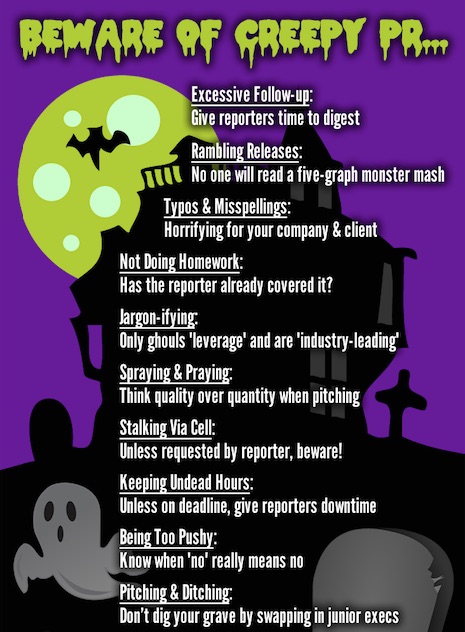Tips To Avoid Scary PR
It’s that time of year again when we share our tips for avoiding creepy PR (aka bad media relations). Heed these warnings to avoid ghoulish mistakes and frightening outcomes in your public relations media campaigns.

It’s that time of year again when we share our tips for avoiding creepy PR (aka bad media relations). Heed these warnings to avoid ghoulish mistakes and frightening outcomes in your public relations media campaigns.

If you work in PR, chances are good that you’re a master multi-tasker. But even the best juggler needs a helping hand from time to time. That’s why we’ve compiled a list of our favorite apps, gadgets and websites to help you streamline your act and even add to it without dropping a single ball.
We know these are very few of the many time saving and time enriching tools out there. So, please share your favorites in the comments. The more we share, the more we all benefit. And this is the giving season after all.
Cheers!
This week you’ll see plenty of ghouls and goblins, tricks and surprises. But fear shouldn’t be a part of your PR campaign! Here are our tips for avoiding ghoulish PR. (And if you need some help, who ya gonna call?!)
Ok, so there may not be presents, fireworks or candy to mark the occasion, but we can assure you that lexicographers across the country are certainly celebrating today. (Don’t know what a “lexicographer” is? There’s no better way to partake in this unofficial holiday than to break out your dictionary!)

Why? Noah Webster, otherwise known as the “father of the American dictionary,” was born today in 1758. Fun fact: It took him 27 years to complete his first dictionary in the English language!
But rather than break out our dusty books in honor of the event, we thought we’d pay homage by talking about what’s inside them, as that’s the true impetus behind this annual observance.
See, as PR professionals, we rely on the word (both written and spoken) daily. Just as Edward Bulwer-Lytton said in 1839, “The pen is mightier than the sword,” we, too, know the power of words and their ability to inform, inspire and even incite action.
Whether we’re writing a pitch, press release or bylined article, we’re constantly aware of the words we choose – and how their tone and meaning will be interpreted. In fact, as we’re creating and circulating information on behalf of our clients, we strive to stay adept at striking a balance between keeping the messaging consistent and the language fresh.
So take a few moments today to open or click onto a dictionary, and peruse a few new words to add to your vocabulary. If you’re in need of some inspiration, go to www.worldwidewords.org, or check out our infographic above, which highlights a few of our personal favorites. We’d also be remiss if we didn’t include a few words from Mark Twain, a man who had a definite way with them:
“The difference between the right word and the almost right word is the difference between lightning and a lightning bug.”
The lesson here for us PR folks? Words are the building blocks for success, as they can help you communicate more clearly, yield better results and separate yourself and your clients from the competition. Use them wisely!
“How do fevers in the human brain produce the dreams and visions that become transformed into blazes of insight?” The Creative Brain
When I was in college, I was proud to be studying at a University that had its PR program in the School of Business, resulting in a Bachelor of Science in Business degree. This was – and stills seems to be – a rarity in the field. Most PR and Marketing degrees are housed in the School of Communications and/or result in a Bachelor of Arts. In the past, this seemed to make sense for PR – it reflected the creative arts side of the field – writing, event planning, branding, messaging, etc. But today, with the explosion of analytics and data in the field, PR and Marketing executives have to think differently. They need to use both sides of their brain – the right, creative side and the left, analytical side. (Luckily, my degree prepared me for both before the market turned that direction.)
The creative side of the brain is still crucial to coming up with marketing strategies, branding and messages that appeal to people. We have to understand how to entice strong emotions that lead to action. Once that action is taken, we now have to use the right side of our brain to determine if that action resulted in value to our organization (or our clients’ organizations). Our creativity is crucial when it comes to content – we are in fact content creators and publishers in the day and age of social media. It takes fun, whimsy and innovative risk taking to create content that’s really going to stand out. But in order to truly create the best content, we need to use the right side of our brain to analyze how that content – if that content is working.
It’s not enough anymore to say “That was a really catchy headline” or “The logo is awesome” – or even to just write a creative pitch that gets a reporter’s attention. We now need to drill down and, after the reporter writes his or her article, analyze if the messages within drove the right interest. Was the article placed in the right outlet? Did the messages appeal to the right audience? What did they do as a result? Did they click through to our site? Did they buy? Why or why not?
This movement is also reflected in the banter about CIOs and CMOs battling for budget and suddenly sharing some tech responsibilities. CMOs are responsible for more data-driven decisions than in the past, and that includes managing the website’s content (which CIOs also need to make sure doesn’t then result in slower performance or other issues), and purchasing analytical software. As Dell chief information officer Andi Karaboutis recently told ZDNet, “Things for which I work together with Karen [the CMO]? Analytics, big data.”
And thus, today’s best PR and Marketing executives are what I’ve dubbed “Creatalitics” thinkers. They combine really creative and innovative ideas – those “dreams and visions” with data and analysis – the “blazes of insight” that tells them if their creations go beyond initial appeal and into the world of actionable value to the company’s bottom line. How are you using “creatalitics” in your PR or marketing position? If we can help you better undersatnd and merge this new way of thinking into your organization, let me know.

Photo courtesy of Tech Cocktail
PR practitioners used to have it easy! Remember the good ‘ol days when it was all about our media relationships and campaigns were linear, like this?
Ok, that’s simplifying things quite a bit, but you know what we mean.
Now, though, the entire landscape has changed with the explosion of the Internet, which has removed virtually all barriers to publication. Suddenly we’re responsible not only for the message, but also the mode and the medium, which follows more of a vicious cycle:
Software Advice‘s article on The B2B Marketing Mentor does a great job of explaining the creation and importance of this new kind of role that merges marketing, PR and journalism functions.
In an nutshell, since we now play a larger part in the production of content (journalism), we’re no longer simply pitching and promoting it (PR), but are challenged to leverage it as a strategic tool for lead generation and brand awareness (marketing).
The only problem is that, well, everyone else is doing the same thing, which means it’s pretty noisy out there as we all compete for the time and attention of our audiences.
That’s where the shift to “inbound” comes in; it’s an offshoot of content marketing that focuses on aligning content with customer interest so that they are “pulled” toward your company, rather than the old-school spray-and-pray methods.
We’ve embraced this, both in theory and in action, with our clients. In fact, we recently attending the Inbound Marketing Summit in San Francisco and the Inbound Marketing Conference in Boston where we talked about how it’s not about being the loudest; it’s about having the right content for the right audience at the right time.
Put simply, the only way we can guarantee our clients are in the media nowadays it to help them become the media. Content has become their new currency when attracting, engaging, converting and retaining customers.
Savvy PR professionals are embracing their status as content custodians. But the most successful ones will recognize the beauty in marketing’s ability to measure return and directly tie to their clients’ bottom line.
 If the number one thing on which PR people are judged is our reporter rolodex, grammar and spelling savvy ranks a close second. Make sure you don’t fall prey to some of these common mistakes:
If the number one thing on which PR people are judged is our reporter rolodex, grammar and spelling savvy ranks a close second. Make sure you don’t fall prey to some of these common mistakes:
No. 1: Your & You’re
“Your” is possessive, as in “your client” or “your press release,” when “you’re” is a contraction of “you are.” A handy tip: When in doubt, insert that phrase (you are) into the sentence, and use it if it still makes sense.
No. 2: Its & It’s
Same idea here – “its” is possessive, as in “the early bird got its worm,” whereas “it’s” is a contraction of “it is.” Try the same swap in a sentence – you wouldn’t say, “the early bird got ‘it is’ worm,” right?
No. 3: Numbers
According to AP Style, numbers one through nine should be written out, and figures should be used for 10 and above. (Bonus: When writing percentages, always use numerals with the word “percent,” not “%.”)
No. 4: Fewer & Less, More Than & Over
Use “fewer” with things you can quantify (e.g. fewer than 10 pieces of coverage), whereas “less” is used with hypothetical quantities (e.g. Their launch was less successful than ours). Along those same lines, “more than” is used with numbers, where “over” generally refers to spatial elements (e.g. She sent more than 25 tweets; I positioned the logo over the text in the document).
No. 5: Complement & Compliment
To “complement” something is to add to or supplement it (e.g. That color really complements your complexion), whereas a “compliment” is an expression of praise or admiration (e.g. That color looks great on you!).
No. 6: Into & In To
The word “into” answers the question, “where?” – although it doesn’t necessarily need to be a physical place (e.g. I walked into my office). The words remain separate when they happen to show up next to one another in a sentence (e.g. My boss came in to see me).
No. 7: E.g. & I.e.
The abbreviation e.g. is Latin for “exempli gratia,” meaning “for example.” The abbreviation i.e., on the other hand, stands for the Latin “id est,” meaning “that is to say.” Here’s an example: “We like social media—e.g., Facebook, Twitter, LinkedIn.” Or you might write, “We like social media—i.e., we’ve made a point of connecting with others.”
No. 8: That & Who
Always use “who” when referring to people. Otherwise, if you say something like, “employees that are present today in the office,” you’re referring to them as objects.
No. 9: Affect & Effect
“Affect” means “to influence” (e.g. This heat is affecting my ability to concentrate), whereas “effect” is a result (e.g. The heat has had an effect on productivity levels in the office).
No. 10: Alot & A Lot
Trick question! “Alot” is not a real word, so always be sure you separate the two. And, when in doubt, try to replace it altogether with a number or something like “many” or “ample” to sound more professional.
 To say that the lines between PR, media and marketing are blurred is putting it mildly. What was once about facilitating and gatekeeping has now become a creative free-for-all as more brands step into the role of content makers to try to strike a chord with their respective audiences.
To say that the lines between PR, media and marketing are blurred is putting it mildly. What was once about facilitating and gatekeeping has now become a creative free-for-all as more brands step into the role of content makers to try to strike a chord with their respective audiences.
As an agency, we’re constantly thinking about best practices among the complimentary disciplines, along with how we can leverage a combination of them most effectively for our clients.
One of the more recent discussions was around engagement on social media. While we’re all familiar with it from a personal perspective, it’s still an area that can be a challenge from a business standpoint.
Even though there’s a general understanding among brands that social media is a marketing tool that can help them reach out to their customers, it can be difficult to convince them to loosen the reins and fully harness their network’s power to unlock the true potential.
 But rather than brainstorming something like a list of the “10 tips for better social media engagement,” we simply wanted to show an example of the magic in action in this video from UK maxipad maker Bodyform, made late last year. The company created it in response to a man’s tongue-in-cheek “rant” on their Facebook wall, claiming that he’s been lied to about the “happy periods” depicted in their ads over the years.
But rather than brainstorming something like a list of the “10 tips for better social media engagement,” we simply wanted to show an example of the magic in action in this video from UK maxipad maker Bodyform, made late last year. The company created it in response to a man’s tongue-in-cheek “rant” on their Facebook wall, claiming that he’s been lied to about the “happy periods” depicted in their ads over the years.
What might make some brand managers bury their heads in the sand to avoid addressing, Bodyform embraced as an opportunity to get a conversation, ahem, flowing in its community.
“We found Richard’s post very amusing and wanted to continue the positive dialogue around periods that this generated,” said Yulia Kretova, brand controller for Bodyform, in a statement. “…Breaking down the taboo around Bodyform and periods has always been a challenge, and I hope that we have started to address this.”
The result? Well, not only did it delight fans and followers, but the video went viral, and we’re still talking about it months later as a hilarious – and effective – example of engagement at its best.
While the saying “no publicity is bad publicity” will always be up for debate, there’s no denying that any kind of feedback – even negative – can be a major opportunity in social media to convert its loudest naysayers into its most fervent fans. And that’s something none of us should overlook – period.
 Between client deadlines, monitoring headlines – and everything in between – regular gym visits all too often slip down (or completely off) a PR person’s daily to-do list.
Between client deadlines, monitoring headlines – and everything in between – regular gym visits all too often slip down (or completely off) a PR person’s daily to-do list.
But this lack – or total absence – of activity is serious business: According to this infographic by Medical Billing & Coding, most of us spend more time on our behinds (9.3 hours per day) than in bed (7.7 hours a day), and this sedentary lifestyle (i.e. sitting for more than six hours a day) can increase your risk of death up to 40 percent.
Wait…what? Yes, simply put, the more you sit, the shorter your lifespan, which is a very scary prospect.
But the good news is there’s something we can do about it. Even if squeezing in an hour-long sweat session into your day isn’t feasible, there’s still hope for staying in shape. By incorporating short bursts of exercise into your day, it’s easy to increase your overall level of physical activity and help stave off things like obesity and cardiovascular disease.
This doesn’t have to involve sprinting around the office so you arrive sweaty to meetings, however; keep it simple and gradually work your way up to more movement as your body adapts.
Here are a few simple desk exercises to get you started.
Perform three rounds of each exercise with 10 reps each (and just three one-minute segments of the plank) for a complete workout, or break it down and do one exercise at a time throughout the day.
What are you waiting for? Get off that heiney and on the road to better health!
With headquarters in Boston, the PerkettPR team is naturally composed of many sports fans. As we gear up to watch the Bruins win the Stanley Cup, keep an eye on the Red Sox and their unique manner of winning, and listen to the controversy over the New England Patriots‘ most recent player acquisition, we can’t help but think about how PR is often a lot like sports. It takes a team to win, but each player must be at their best and support each other. You’ve got to keep an eye on the ball, practice a lot, and analyze your plays in order to stay ahead of the competition. If your pitches aren’t quite right, you’ve got to recalibrate or sometimes pull the player. You’ve also got to deal with tough management decisions and sometimes you have to rebuild after a bad season where things didn’t quite work out the way you had planned.
In particular, we liken PR to baseball – how could we not with all those PR “pitches” – in the graphic below. What do you think – did we score?
